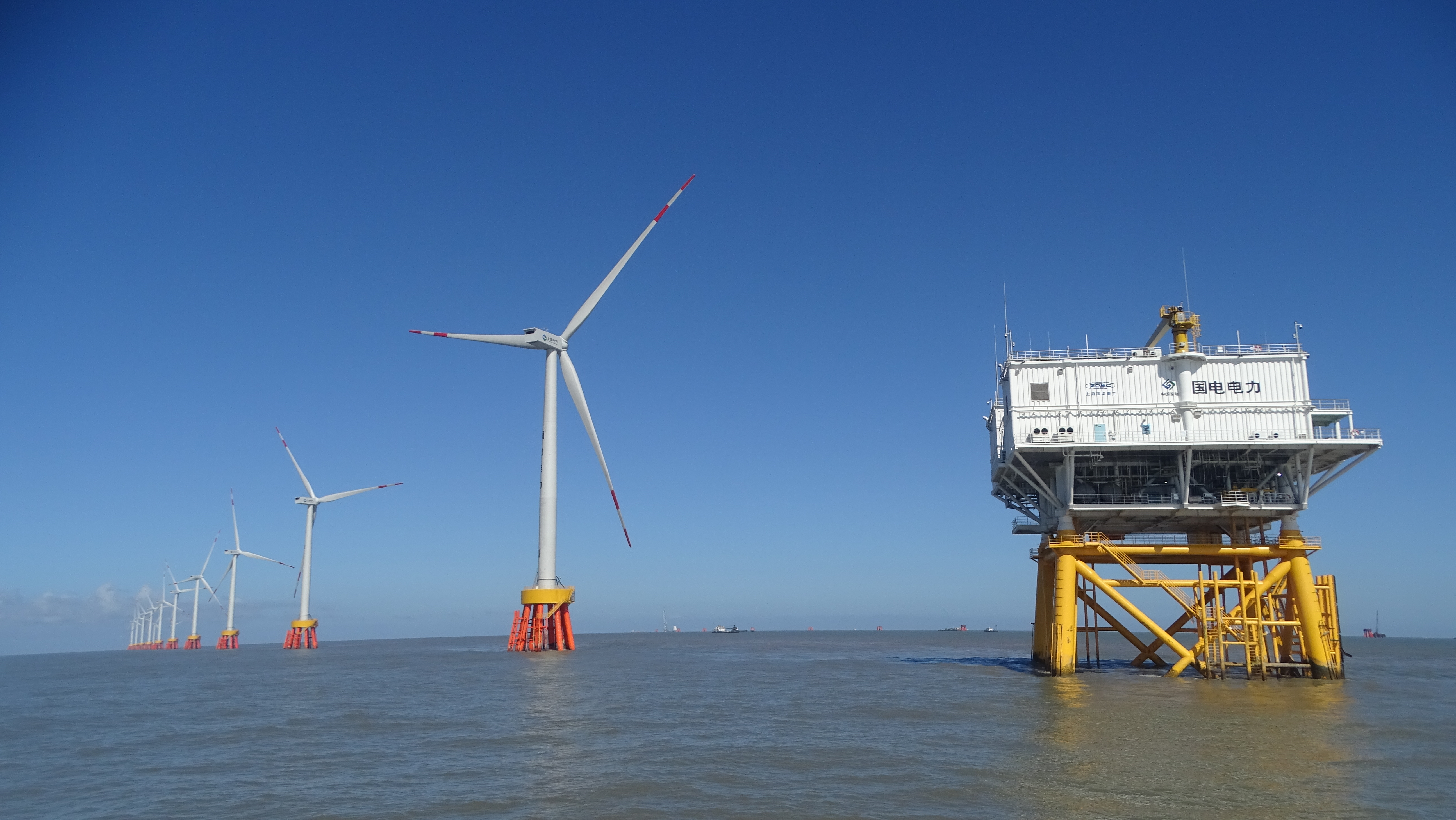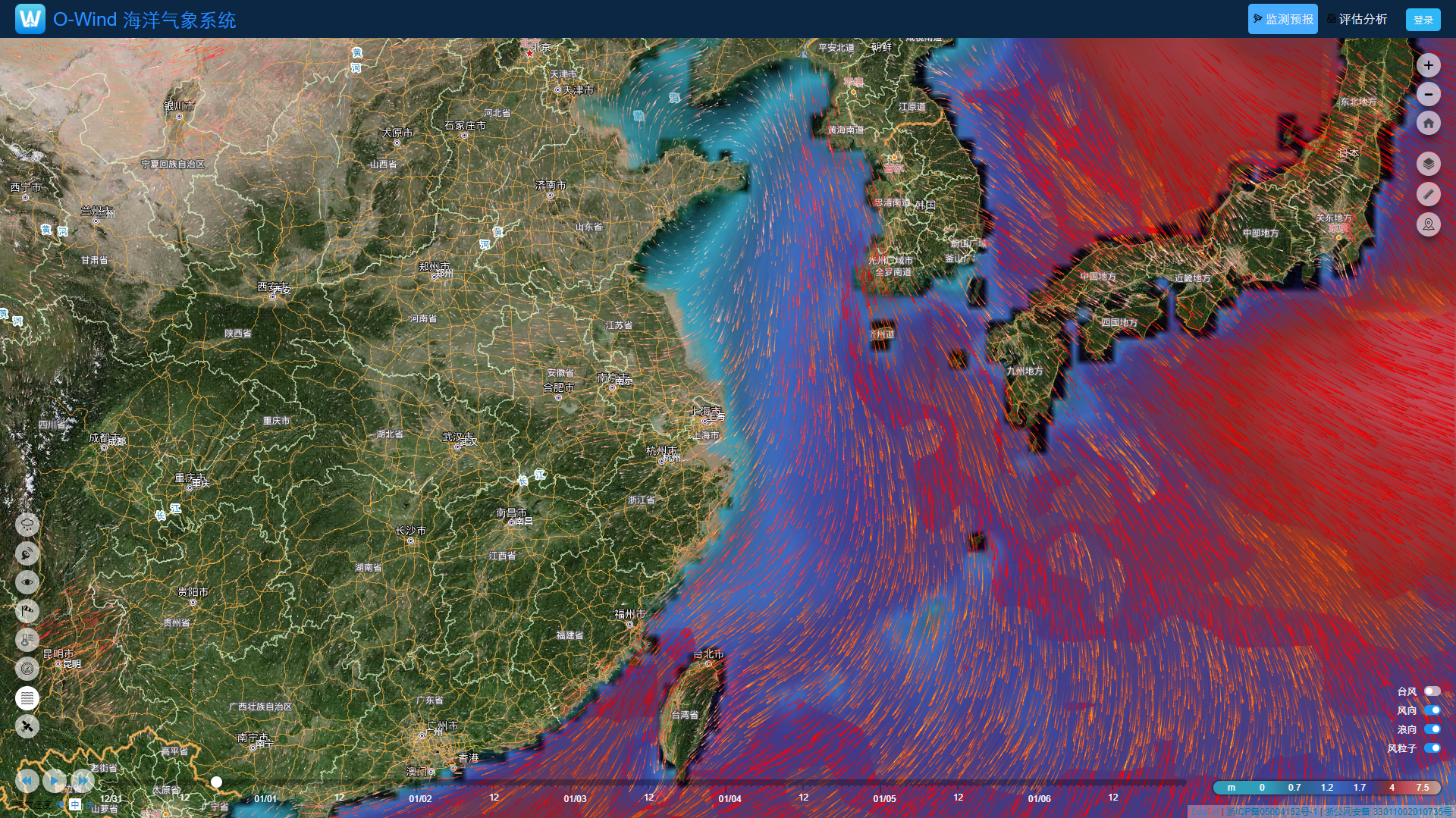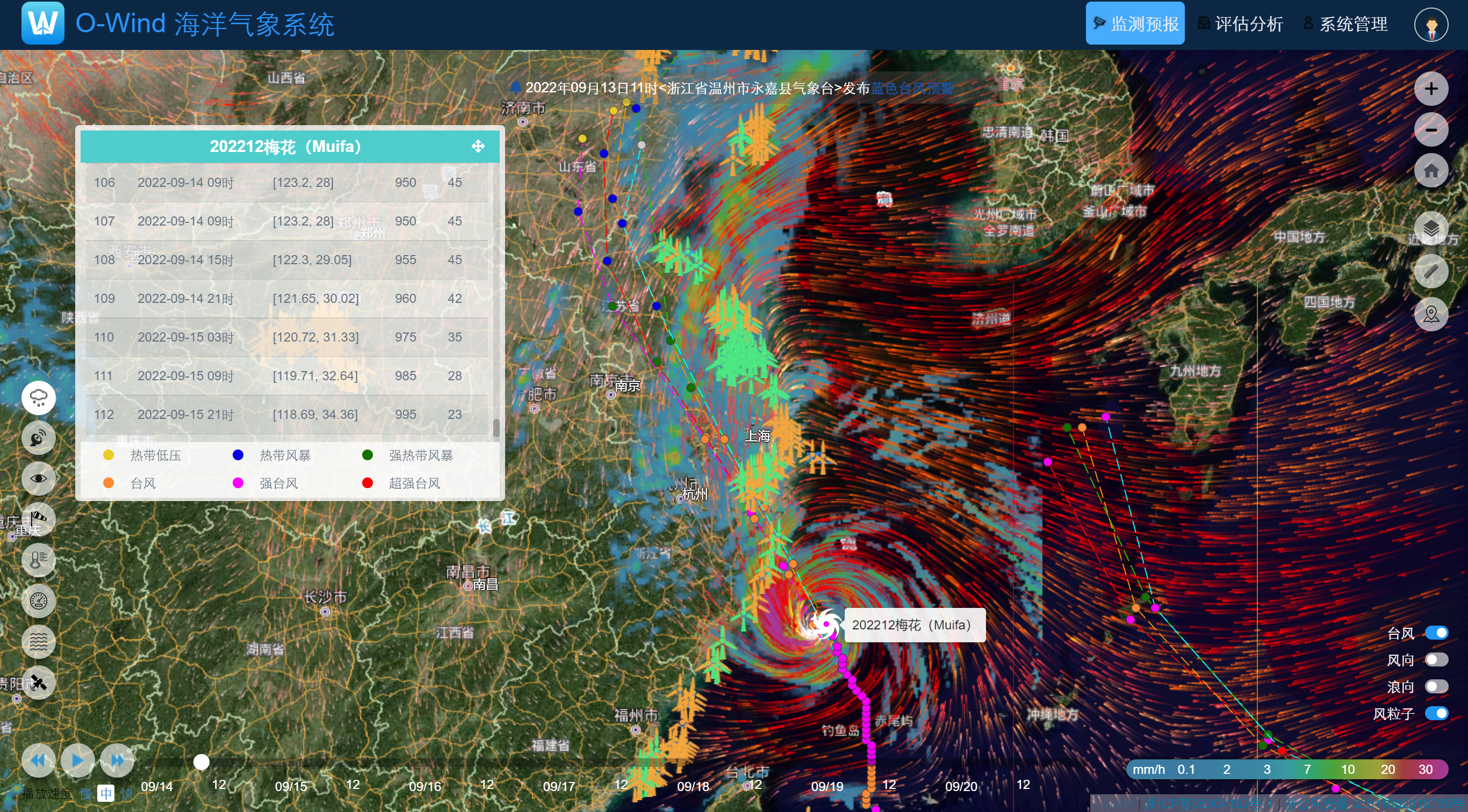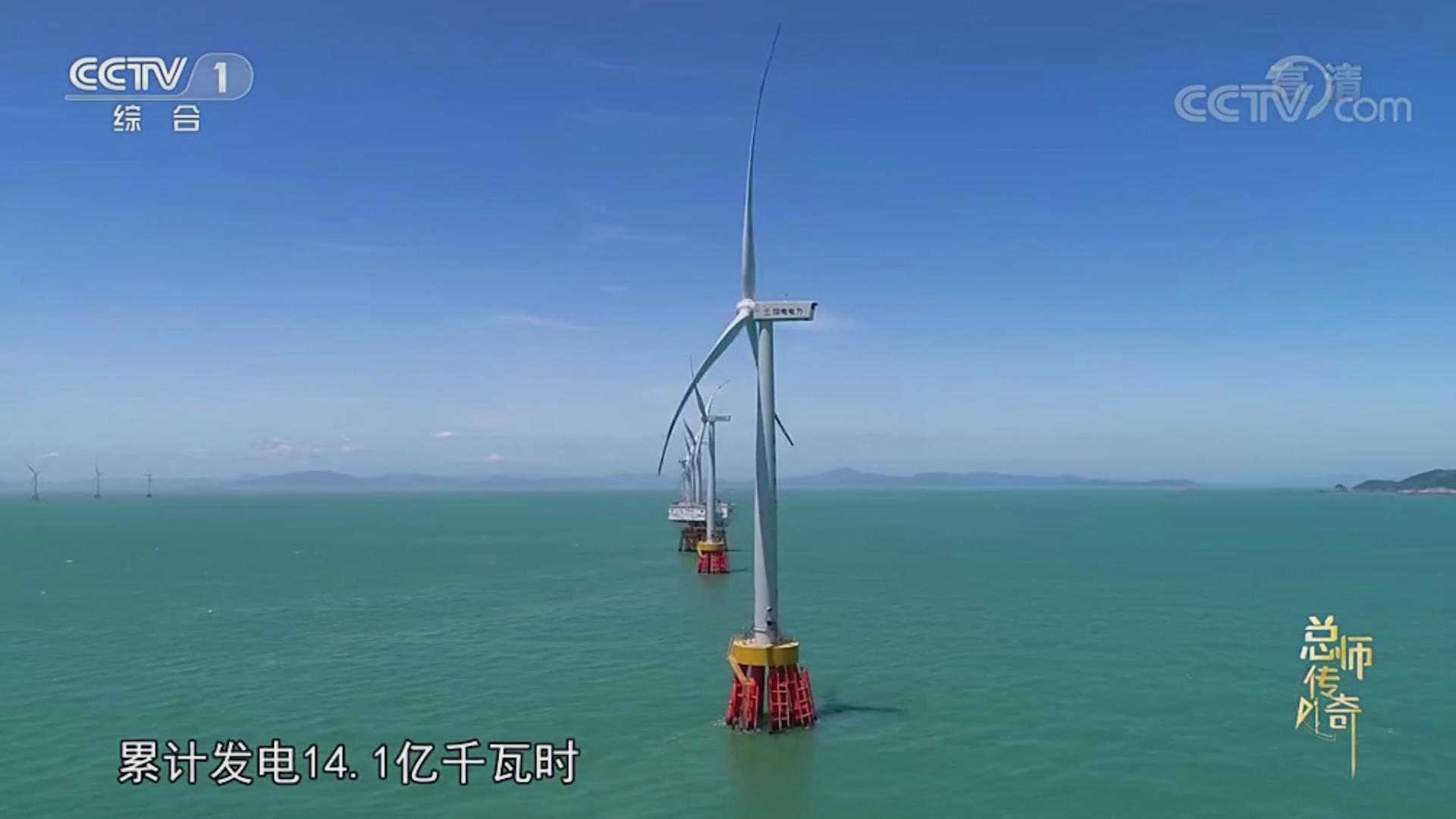
Guodian Zhoushan Putuo No. 6 Offshore Wind Farm in Zhoushan City, east China's Zhejiang Province, January 2, 2022. /Li Wei
Guodian Zhoushan Putuo No. 6 Offshore Wind Farm in Zhoushan City, east China's Zhejiang Province, January 2, 2022. /Li Wei
As scientists say, extreme weather is hitting new highs and rewriting climate history in 2023, but some wonder: can we 'turn damage into treasure' and benefit from these scorching heatwaves, ultra low temperatures and overwhelming windstorms?
CGTN talked this over with Li Wei, chief engineer of Renewable Energy Engineering Institute, PowerChina Huadong Engineering Co., Ltd. (HDEC), also a Chinese expert with special government allowances from the State Council.
He believes that some extreme weather, such as typhoons, can not only bring about storms but also strong winds that can be beneficial for wind farms.

The O-Wind marine meteorological system independently developed by PowerChina Huadong Engineering Co., Ltd. (HDEC) /HDEC
The O-Wind marine meteorological system independently developed by PowerChina Huadong Engineering Co., Ltd. (HDEC) /HDEC
What are three major types of typhoons that land in China?
Li said according to China's current standards and performance indicators, typhoons that land in the country can be divided into three categories: profitable, defensive and destructive.
The profitable type, which is affected by the typhoon's periphery, has a maximum wind force below level 10, with a maximum wind speed of less than 24.5 meters/second (m/s) near the typhoon center upon landing.
The defensive type, which is affected by the typhoon's periphery, has a maximum wind force between level 10 and level 11, with a maximum wind speed ranging from 24.5 m/s to 32.6 m/s.
Meanwhile, the destructive type, which is affected by the typhoon's periphery, has a maximum wind force above level 12, with a maximum wind speed surpassing 36.9 m/s.
Gradually, with the development of offshore wind power technology and innovation of wind turbine structures, how typhoons are categorized will be updated. China's ability to withstand typhoons of 12 level or above will also be enhanced.
The categorization of typhoons provides constructive guidance for the economic and safety considerations of wind turbines affected by typhoons that land in China, said Li.
Can typhoons 'turn damage into treasure'?
When a wind farm encounters a profitable typhoon, the airflow is relatively stable and the windy weather is relatively less destructive, said Li.
Therefore, the strong wind can be converted into an effective source of clean energy generation such as wind power.
Affected by typhoons Sura and Haikui, China's self-developed 16-megawatt offshore wind turbine off the coast of east China's Fujian Province set a new world record for single-day electricity generation per unit on September 1, according to its operator China Three Gorges Corporation (CTGC).
With the maximum wind speed of 23.56 m/s, the turbine has worked at its maximum power capacity for a continuous 24-hour period and achieved a daily electricity output of 384,100 kWh, which is equivalent to the daily electricity consumption of nearly 170,000 people, said the CTGC.
In 2018, typhoon Ampil landed on the coastal regions of Chongming Island, Shanghai. When it passed through Jiangsu Province's Rudong County, its maximum wind force reached level 9 with a wind speed of 23 m/s.
It generated 1.56 million kilowatt-hours of electricity to a wind farm in Rudong in just one day, which is approximately 700,000 kilowatt-hours more than the average daily power generation of the wind farm.
However, defensive and destructive typhoons directly affect the safety of wind turbines and require tech breakthroughs to better utilize their resources, said Li.
For example, we can develop and manufacture wind turbines that can capture wind energy under strong wind conditions, or dealing with the impacts of typhoon passing vortices.
On the hardware side, we can use a backup power system and its automatic switching control loop, while for the software part, we can develop a typhoon control strategy system through customized typhoon control processes and control algorithms to enhance the adaptability of wind turbines to typhoon conditions, Li added.

The O-Wind marine meteorological system forecasts for Typhoon Muifa, September 13, 2022. /HDEC
The O-Wind marine meteorological system forecasts for Typhoon Muifa, September 13, 2022. /HDEC
What technologies can 'turn damage into treasure'?
To improve the adaptability of wind power to extreme weather, Li told CGTN that it is necessary to promote coordinated development of multi-professional and multi-field technologies.
First, we need to strengthen the ability of meteorological theoretical models such as atmospheric circulation to predict extreme weather, improving the ability of renewable energy power generation systems to cope with extreme weather conditions.
By modeling the Earth's atmospheric system, simulating the movement of air, water vapor and clouds, the occurrence of extreme weather is predicted by data method and the model prediction results are improved by satellite observation data.
Second, sound industry standards and specifications are needed to guide wind farm site selection and wind turbine manufacturing to ensure that equipment can continue to operate reliably under different environmental conditions.
The third is to improve the design and manufacturing level of wind turbines, such as by developing new wind turbines, or reinforcing traditional wind turbines, so that the units can operate stably in extreme weather.
The fourth is to optimize wind farm operation and safety management, and take effective measures to ensure that wind turbines can generate electricity safely and stably under typhoons, Li added.

The O-Wind marine meteorological system forecasts for Typhoon Muifa, September 14, 2022. /HDEC
The O-Wind marine meteorological system forecasts for Typhoon Muifa, September 14, 2022. /HDEC
Where do countries stand in the field?
Li told CGTN that China is now in a leading position in the evaluation of typhoon wind measurement data.
Most of the current design standards for wind turbines at home and abroad originate in Europe, based on European climate and environmental characteristics without consideration of the impact of tropical cyclones.
International Standard IEC 61400-1, which specifies essential design requirements to ensure the structural integrity of wind turbines, clearly states that the wind conditions defined by existing standards cannot cover all areas affected by tropical cyclones.
Therefore, wind turbines designed according to the above standards lack sufficient reliability in typhoons. In order to fill the gap, China published a series of standards to improve the usability of relevant standards based on IEC 61400-1.
To name some of them, wind turbine generator systems design requirements (GB/T 18451.1), specification for typhoon cyclone observational wind data differentiating (GB/T 36745) and technical specification for effect evaluation of tropical cyclone on offshore wind power project (GB/T 38957).
According to Li, globally speaking, most solutions for optimizing the design and manufacturing of wind turbines are currently in the research stage.
Some scholars have proposed a wind turbine that has no blades and instead uses a strong central cylinder to catch the wind.
The "Magnus Force" generated when the rotating cylinder encounters the wind is used to drive the generator and can fully respond to changes in wind direction, increasing the cut-out wind speed of the wind turbine from 25m/s to approximately 40m/s.
Others studied and proposed a typhoon power generation system which can use typhoons to generate electricity after landfall. This method can generate good power and also mitigate damage from the typhoons.
Li believes that through technological iteration, there will be certain breakthroughs in the future of wind turbines adapting to extreme weather.
Are there successful cases in China?
The Guodian Zhoushan Putuo No. 6 Offshore Wind Farm, designed by PowerChina Huadong Engineering Co., Ltd., is China's first offshore wind farm built in areas with strong typhoons and thick mud.
The project won the Gold Medal of National Quality Engineering Award as a benchmark project for offshore wind power that can be replicated, promoted and used as a reference. It was featured in "The Life of a Chief Engineer", which was produced by China Media Group (CMG).
Facing difficulties of constructing large-scale offshore wind power projects in waters with bad sea conditions, the project team must master a complete set of core technologies that can successfully withstand the impacts of several super typhoons such as "Lekima".
Moreover, the O-Wind marine meteorological system independently developed by PowerChina Huadong Engineering Co., Ltd. is a smart system that integrates monitoring, forecasting and early warning systems.
The system is able to integrate the high-resolution numerical forecast results with multi-channel geostationary satellite remote sensing data from many sources.
It can then forecast the offshore meteorological elements, weather phenomena and wind resource changes of the wind farm for the next seven days.
The system can also provide hourly meteorological service support for the safety of on-site construction operations and timely feedback on complex and changeable marine meteorological warnings.

A screenshot of CMG video "The life of a chief engineer" showing Guodian Zhoushan Putuo No. 6 Offshore Wind Farm in Zhoushan City, east China's Zhejiang Province. /CMG
A screenshot of CMG video "The life of a chief engineer" showing Guodian Zhoushan Putuo No. 6 Offshore Wind Farm in Zhoushan City, east China's Zhejiang Province. /CMG
Can economic benefits be truly achieved?
Converting extreme weather into an effective source for wind power can indeed bring economic benefits, said Li, bringing about several concerns on whether we can truly 'turn damage into wealth.'
Li's first concern is the frequency and duration of extreme weather. If extreme weather is too rare or short-lived, it may not be economical to convert extreme weather into an efficient source of wind power.
His second concern is the technical level and cost of wind power generation. If the cost of wind power is already high in extreme weather-affected areas, converting it into an efficient source of wind power may not be cost-effective.
The third one is the market demand. If the market demand for wind power is high and the price is also high, then converting extreme weather into an efficient source of wind power may have better economic benefits, said Li.
What are the challenges ahead?
Looking into the future, in order to realize the conversion of 'damage into treasure' the chief engineer pointed out several challenges.
Firstly, Li said that there is still room for improvement in the current level of extreme weather prediction, which requires the integration of professional meteorological services and engineering that are both accurate and cost-effective.
China's traditional meteorological services are mainly led by the government, providing welfare services such as disaster prevention and reduction for the public, but professional meteorological services in specific scenarios such as energy are still in the initial stages.
To improve professional meteorological service capabilities, it is necessary to obtain a large amount of observation data, develop computing power, and promote high-precision and high-resolution meteorological models and algorithms, which require substantial and sustained investment, said Li.
Secondly, the chief engineer continued by saying that the current investment in research and development and technological maturity related to wind turbine equipment is still low.
It is necessary to improve equipment manufacturing capabilities, strengthen the safety maintenance of key components, and control the entire process from equipment manufacturing, installation, operation, and maintenance, ensuring wind power generation and unit operate safely and stably.
Furthermore, the control strategy should be formulated according to the weather and climate characteristics and features of the fan unit, so as to ensure the stable operation of the unit in the complex environment and the effective response in the emergency situation, giving play to the wind power efficiency.
The last but not the least, the chief engineer mentioned that the legal and insurance systems related to the operation of wind farms affected by extreme weather need to be further improved in the future.
Read More:
Tech Talk: How to ensure wind power supply under extreme weather?